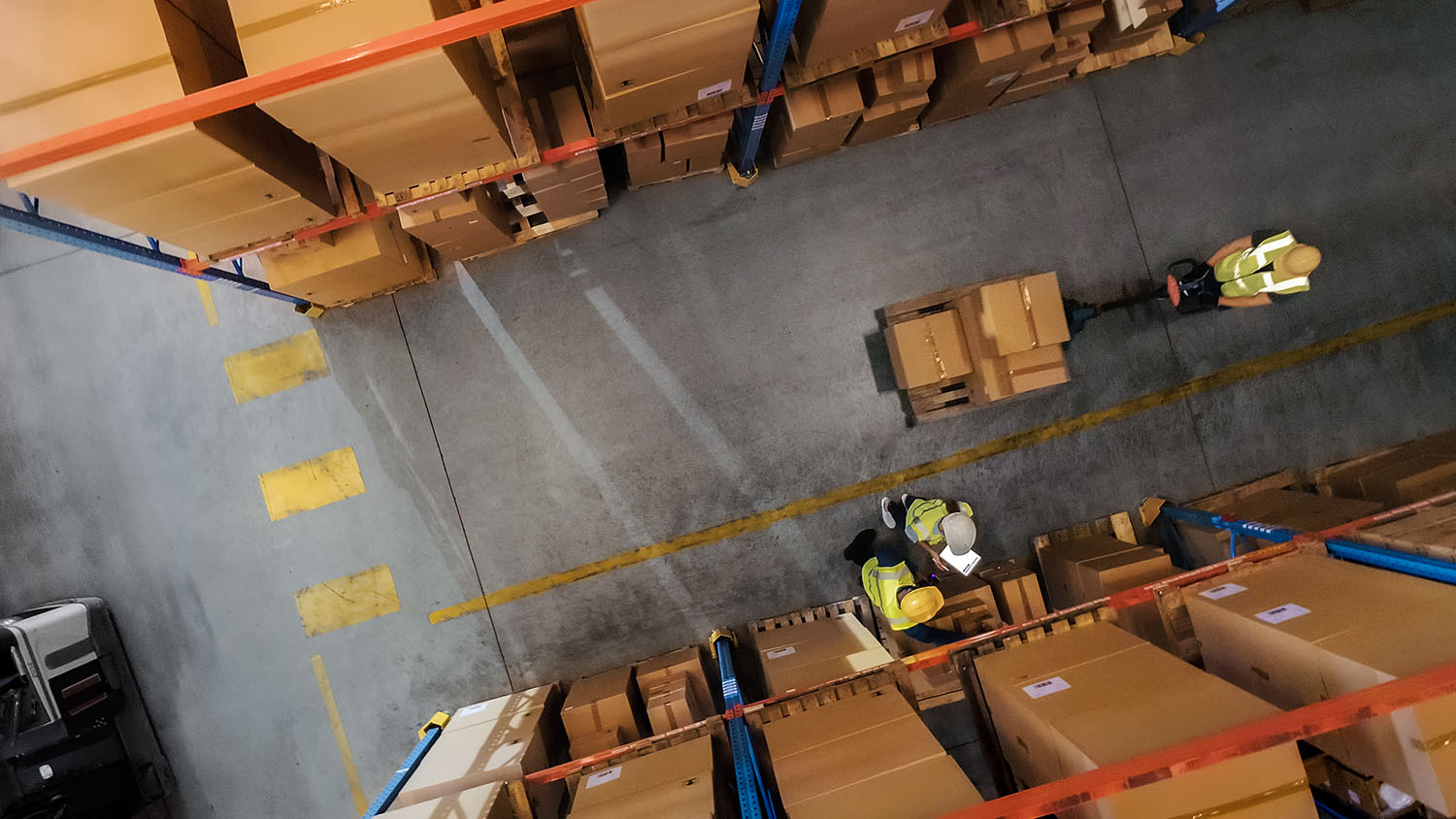Growing competitiveness, fluctuations in the market, increasing customer demands and supply chain issues are all prompting warehouse operators across the country to push for greater efficiency to help them increase profitability.
Enhancing warehouse efficiency in an expanding but increasingly challenging industry is critical— and thankfully there are ways that you can streamline your warehouse operations and improve your bottom line at the same time. Here’s five things every warehouse operator should implement.
Download the PDF
1. Increase labor efficiency
When looking to optimize warehouse operations and cut costs, many businesses first look to labor efficiency. That’s because labor accounts for a large portion of costs, as well as the greatest opportunity to work smarter.
The first place to start is to invest in a warehouse management system (WMS) that can automate and streamline your fulfillment process. At the click of a button, your WMS can create efficient pick paths that are optimized for speed and accuracy, taking the guesswork out of fulfilling the most amount of orders in the least amount of time.
Look out for these picking methods to accelerate labor efficiency:
Advanced picking methods
Rather than manually planning pick paths, your WMS will be able to automatically create the best and most efficient paths. Having a paperless and configurable picking process will help you fulfill orders with less labor and greater speed, helping to save and make money at the same time. There are different types of advanced picking methods, from wave and batch picking, to cart picking, and each has their own advantages depending on the order volume and warehouse design.
Batch picking means that one picker can pick a batch, or group, of orders simultaneously, one SKU at a time. This method is beneficial when there are multiple orders that have the same SKU, as the picker will only need to travel to the location of that SKU once and can fill multiple orders at the same time.
Wave picking maps out picking routes based on a common factor such as shipping date, like items, or the warehouse zone. This picking method makes it easier for teams to meet specific requirements, such as shipping deadlines or meeting a set number of orders per shift.
Zone picking allows you to allocate your pickers to distinct zones in your warehouse. This simplifies picking for temperature controlled zones, such as for frozen goods and dry goods, or zones for fast-selling products and others for slow sellers. You may also need to zone based on other variables, like special picking requirements or restricted items.
Cart picking means you can pick and pack multiple orders simultaneously, with picking staff going directly to the location of the items they need using a cart, where they can deposit and sort items as needed. Cart picking can complement other picking methods, such as batch picking or zone picking, as it reduces the time and foot print to complete several orders at the same time.
Smart pick logic, no matter the method you choose for your warehouse, helps to reduce operational costs and increase throughput, which have a direct impact on your bottom line. Barcode scanning The data transfer from warehouse floor to inventory management system needs to be accurate and automatic for smooth operations. Not only does it affect order throughput, picking accuracy, and replenishment, it directly impacts your profits. That is why many warehouses prefer barcodes to label individual items, locations, pallets, and shipments. Using a barcode/RF scanner allows you to seamlessly capture data and validate it automatically within your system. It’s one of the fastest, most efficient and accurate ways to store and log warehouse data.
Being able to record realtime data by scanning means that updates are instantly sent to the WMS while staff are moving around the warehouse. This means that their movements are not hampered by stock discrepancies or inaccurate inventory data, and orders can be picked and packed as quickly as possible. It also removes the need to manually record data, which not only saves time and money, it leaves less room for error.
While barcode scanning is the most simple and efficient way to automatically collect data, there are a few things that need to be considered to ensure it is utilized properly. The warehouse lighting, the depth of field, capabilities of the mobile devices, and label size will all affect the efficacy of barcode scanning.
2. Key integrations for seamless order processing
Your business is complex. With all the moving parts from sales, fulfillment, finance and accounting, procurement, and human resources, you require data accuracy and warehouse efficiency across the board. The best way to achieve this is to have a fully integrated supply chain system.
Your warehouse management system is just one part of the puzzle to managing your operations and improving profitability. Data transparency and accuracy across systems is key to making crucial cost-saving decisions and identifying opportunities for improvement and growth. This comes down to seamlessly integrated systems and facilitating accurate and powerful data sharing.
Updating outdated and inefficient warehouse management is one of the first ways that managers can keep up with changing company needs, address increasing operational costs, and integrate seamlessly with other supply chain software. When investing in a new WMS, its integration capabilities will not only help you get a return on investment, they will also help you stay profitable and competitive in the increasingly demanding market.
When reviewing business-critical integrations, consider these essential ones that will help you improve warehouse profitability:
ERP integrations
An Enterprise Resource Planning (ERP) system is important for automating data collection and integrating it across all business operational systems, including the warehouse management software. This full picture view not only shows how each department works with each other, it helps to reveal key areas that are impacting the business (positively or negatively) as a whole. These data insights are crucial for making strategic business systems, and are valuable to growth-oriented businesses.
By avoiding manual data entry and syncing your warehouse management with your ERP, you can avoid costly errors and data discrepancies. Inconsistencies in data not only make it difficult to track business KPIs, it is also one of the fastest ways to lose efficiency and money across your operations. The aim is to create a “single source of truth”, where you have accurate insights and can automate demand forecasting for things like sales, stock, labor, and resources.
Instead of relying on multiple or conflicting sources of information, integrating your ERP and warehouse management system streamlines information flows, stimulates efficiency, and helps you address shifts in the market with speed and agility.
An integrated supply chain system should make your life easier, not harder, and that starts with the integration process. The key is to look for a WMS that provides simple and customizable integrations with your ERP, that way you can ensure your data is synched smoothly to suit the requirements and structure of your business.
EDI integrations
Larger and more complex operations rely on EDI integrations to help standardize their business data exchange, for example between the warehouse and its customers. This streamlines business communications and eliminates the need for paper transactions. EDI is particularly important for 3PL businesses that have a large customer base with varying fulfillment and billing needs.
When integrated successfully, your WMS and EDI partners will allow you to streamline inbound & outbound order transmissions and confirmations, maintain inventory control with realtime processing and simultaneously exchange documents and business data between suppliers and customers. Integrating your EDI gives you instant and secure data transmissions for the business deals that power your operations and more control over how these affect the warehouse’s inbound and outbound inventory.
EDI removes time consuming manual data entry or manual import methods, helping to ensure data accuracy and security. Once in place, you can save time and money sending business communications to suppliers and customers and remove slow, traditional sending avenues that are efficiency (and money) drains.
3. Track labor performance
Labor costs can account for 60–65% of the total cost of warehouse fulfillment (not including shipping). This illustrates how important it is to track and optimize your labor force. Having the ability to accurately capture and analyze labor data means you can better optimize your greatest warehouse assets.
Fluctuations in the labor market, increased demands from customers, and growing competitiveness are adding to the push for greater productivity and labor efficiency. Being competitive and adapting to industry demands is critical to surviving and flourishing as a business. That’s why many businesses are turning towards labor management systems (LMS) to help them optimize and streamline warehouse operations and improve their bottom line.
These are just some of the benefits of an integrated LMS in your warehouse:
Collect realtime data
An LMS gives you the ability to track realtime data so you can see the status of the entire team whenever you need. This visibility allows managers to make labor decisions promptly, react to sudden supply chain changes and maximize productivity. High productivity and throughput levels directly lead to greater profitability and continued growth in a challenging marketplace.
Not only does it help with day-to-day operations, analyzing this labor data over a longer period of time lets you plan around staffing outputs and forecast labor needs for busy or quiet periods. You will quickly find out that running your warehouse with an under or over-utilized workforce can be detrimental to the speed and accuracy of your fulfillment, as well as your operating expenses.
The benefits of an LMS also directly impact customers. As you address shortages and surpluses of labor in realtime, you can better forecast and predict order completion. This means that customers receive their orders on time, no matter how busy your warehouse is.
Set target KPIs
Having powerful data insights allows warehouse managers to benchmark labor performance. This gives clarity on the output of individual team members, revealing those who are excelling, those who may need additional training, or who aren’t reaching their KPIs consistently.
Your labor KPIs could be a range of metrics, anything from picking accuracy, putaway time, receiving productivity, or downtime. Tracking a range of KPIs is beneficial for measuring overall performance, and helps to give employees a range of targets to work towards and measure themselves against, which will create a more empowered, engaged workforce.
These insights provide managers with concrete data to make better labor decisions and understand their teams performance and needs. Identifying time management issues and seeing how much time is spent on specific tasks (such as picking or receiving an order) is a valuable and simple way to inform labor and cost efficiency decisions.
4. Optimize storage
You will know better than anyone that your warehouse storage and layout can have a huge impact on productivity. Haphazard stock placement can lead to inefficient picking, double handling, stock discrepancies, and inbound inventory bottlenecks. It goes without saying that reducing the footprint of your products can save money on storage fees and equipment, or create room for additional storage.
There are plenty of best practices for logical and optimized warehouse storage, such as storing high priority and popular items closest to pack stations and loading docks, but there are also a range of WMS functions that allow you to optimize your storage and operations:
Directed putaway
Directed putaway uses a predetermined algorithm to direct warehouse employees to store stock in the most favorable locations. This algorithm can be programmed to optimize putaway position using a number of criteria, such as parameters around predicted sales volume, price, weight and size, or more specialized criteria. This is particularly useful for warehouse operators that need to separate hazardous materials or store perishable inventory in varying refrigerated conditions.
Directing staff to put inventory away in the final location, instead of relying on a staging area, means less congestion and more efficient use of space in the warehouse. By reducing handling of the product, it also means that fewer errors are likely to occur.
Mistakes in the warehouse, whether from human error or system inaccuracies, can have knock-on effects to profitability. Inefficient storage, picking errors, order delays, and inventory irregularities affect every stage of fulfillment. Instead of workers driving around on a forklift trying to find an empty putaway location, directed putaway takes the guesswork out and allows warehouses to streamline and simplify their layout and enhance work rates.
Directed putaway is also beneficial for storing items together that are often ordered together, and helping to optimize inventory storage by placing popular products in high traffic picking areas. By optimizing warehouse storage and layout, and ensuring your workforce are covering less ground while picking, your operations will be more efficient, productive and in turn more profitable.
Kitting
Product parts or corresponding products are likely to be consistently sold or ordered together. Instead of wasting time and labor costs on picking items individually from separate locations of the warehouse, kitting allows you to pair items together to create a new SKU.
There are many ways that kitting helps to optimize your warehouse: it allows for quick and easy item location, minimal product assembly, and faster order throughput, but one of the most important to warehouse operators is reducing costs. Kitting helps warehouses increase profitability at every stage of fulfillment, from cutting labor costs, optimizing storage capacity, and increasing profits by processing more orders faster.
Implementing kitting processes also provides standardization in the supply chain, helping to simplify and streamline cost modeling. Predicting costs becomes a lot easier when the contents of kits are predetermined, rather than if each component has to be picked and packed separately.
5. Ensure accurate billing
Inaccurate charge capture, manual billing at month-end, lost opportunity on revenuegenerating activities, and other time consuming, inefficient billing processes can end up costing your warehouse thousands. Automating your billing can reduce charge errors, increase your bottom line and can free up time usually spent on billing to focus on other areas of the business, such as customer service.
Accuracy is not only important for your business, it helps to maintain positive relationships with suppliers, customers and clients, which is crucial to achieving business success and continued growth.
Some fulfillment operations are more complex than others, with 3PL companies juggling a wide range of customers with varying billing requirements. If your WMS doesn’t support flexible 3PL billing, let alone streamlined billing, you will likely struggle to stay competitive.
Dedicated 3PL billing
3PL billing capabilities are designed to suit the complex and unique needs of 3PL operators, as many standard billing machines don’t meet the demands of the industry. Automating this process means that customer billing doesn’t rely on human calculation or finalization: customers can expect consistent and accurate billing no matter how much their order volumes change or fluctuate.
If you have a large number of customers, each with a different agreed rate, you can waste a lot of time checking and tracking their individual needs. Powerful 3PL billing lets you create customer level configurations, where you can set-up your own rules and logic for different customer accounts and streamline how you manage varying customer demands.
Conclusion
Profitability is a number one priority for warehouses and distribution centers across North America, as well as the world. In the already complex world of fulfillment and logistics, the focus is on removing unnecessary and inefficient processes. By implementing a warehouse management system that allows you to increase labor visibility and efficiency, automate accurate billing, optimize your inventory storage and integrates seamlessly with your other operational systems, you can improve your profit margins and accelerate growth.



